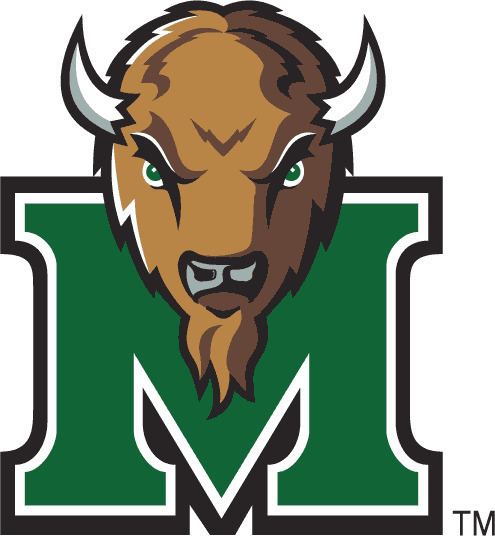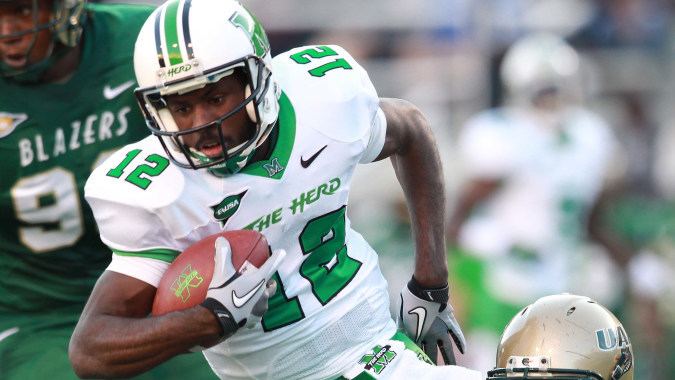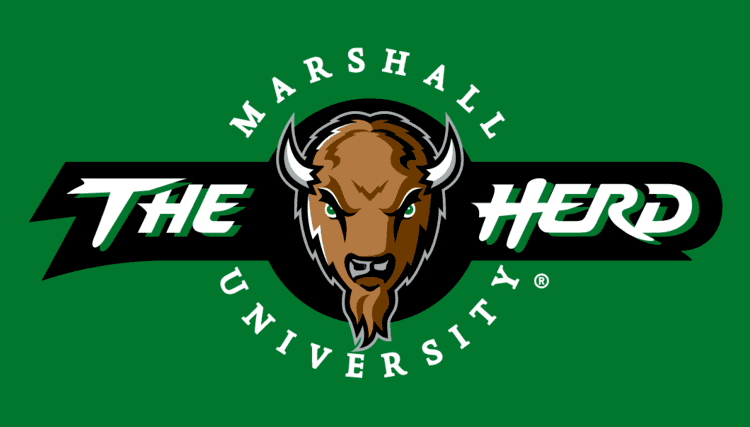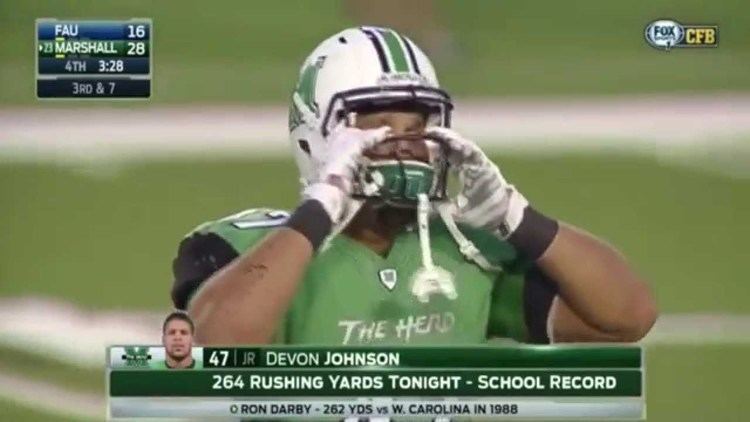First season 1895 Field surface FieldTurf Division Division I (NCAA) League Division I (NCAA) | Athletic director Mike Hamrick Seating capacity 38,227 Mascot Marco the Buffalo | |
 | ||
Rivals West Virginia Mountaineers football, Ohio Bobcats football | ||
2014 ultimate marshall thundering herd football highlights
The Marshall Thundering Herd football team is an intercollegiate varsity sports program of Marshall University. The team represents the university as a member of the Conference USA Eastern division of the National Collegiate Athletic Association, playing at the Division I Bowl Subdivision level.
Contents
- 2014 ultimate marshall thundering herd football highlights
- Early history 18951934
- Cam Henderson era 19351949
- Pete Pederson era 19501952
- Herb Royer era 1953 1958
- Charlie Snyder era 1959 1967
- Moss and Tolley eras 19681970
- Jack Lengyel era 19711974
- Frank Ellwood era 19751978
- Sonny Randle era 19791983
- Stan Parrish era 19841985
- George Chaump era 19861989
- Jim Donnan era 19901995
- Bob Pruett era 19962004
- Mark Snyder era 20052009
- Doc Holliday era 2010present
- Conference championships
- Home venues
- Conference affiliations
- Herd football traditions
- MAC Championship games
- C USA Championship games
- Division I AA Playoffs results
- Bowl games
- All time record vs C USA teams
- Ohio
- West Virginia
- East Carolina
- 1 AA Polls
- 1 AFBS Polls
- All Americans
- College football
- Pro football
- Marshall University Hall of Fame
- Current NFL players
- Future non conference opponents
- References

Marshall plays at Joan C. Edwards Stadium, which seats 38,227 and is expandable to 55,000. As of the end of the 2015 football season, Marshall has an impressive 148-26 overall record at Joan C. Edwards Stadium for a winning percentage of .851. The University of Alabama ranks second with an .825 winning percentage at Bryant-Denny Stadium. The stadium opened in 1991 as Marshall University Stadium with a crowd of 33,116 for a 24-23 win over New Hampshire. On September 10, 2010, the Thundering Herd played the in-state rival West Virginia Mountaineers in Huntington in front of a record crowd of 41,382. Joan C. Edwards Stadium is one of two Division I stadium named solely for a woman with South Carolina's Williams-Brice Stadium being the other. The playing field itself is named James F. Edwards Field after Mrs. Edwards husband, businessman and philanthropist James F. Edwards.

Early history (1895–1934)

Marshall first fielded a football team in 1895. The team didn't have a coach that year or from 1897–1901. The first coach in Marshall football history was George Ford from 1902–1903.

Boyd Chambers was Marshall's head football coach from 1909-1916. He is most well known for calling the "Tower Play," where one receiver lifted another up on his shoulders to complete a pass, during the 1915 season, leading to a rule change in 1916.
Arch Reilly led the Herd to an undefeated 8-0 record in his only season as Marshall's head coach in 1919.
Charles Tallman would lead the Thundering Herd from 1925-1928, compiling a 22-9-7 record before moving on to coach rival West Virginia. Tallman's Thundering Herd won conference championships in 1925 and 1928.
Tallman was succeeded by John Maulbetsch, who posted an 8-8-2 record in his two years (1929-1930).
Tom Dandelet led the Thundering Herd from 1931-1934, compiling a record of 18-16-2. Dandelet's 1931 team won a conference championship.
Cam Henderson era (1935–1949)
Cam Henderson led the Marshall Thundering Herd for a total of twelve seasons (Marshall didn't field a football team from 1943-1945 due to World War II) and posted 69 wins. Henderson coached the likes of Jackie Hunt - who set a Marshall and National record with 27 touchdowns in 10 games, not broken nationally until Lydell Mitchell had 28 TDs in 1971 (12 games) and until Randy Moss had 29 touchdowns in 1996 in 15 games - Frank Gatski (Marshall's only NFL HOF member, who played for 11 championships in 12 years of pro football, winning eight) and Bill Smith (Marshall's first All-American on the AP "Little" (small colleges) All-American teams) during his time at Marshall. Henderson's teams were tough and physical and liked to run the football. Henderson's 1947 Herd was 9-2, then received a bowl bid from the second Tangerine Bowl to face Catawba College (the winner of the first bowl game in Orlando, Fla.). Henderson's 1946-47 basketball team won the NAIA National Championship with a 32-5 club, and earned a bid to the Helm's Foundation's Los Angeles Invitational, so Henderson took the team by train to Denver, flew into LA and also won that tournament. His top assistant, Roy Straight, took the football team minus the two starting ends who went with Henderson, and after a four-day bus trip to Orlando, fell in the Tangerine Bowl on Jan. 1, 1948, 7-0 to Catawba, despite out-gaining and having more first downs. In fact, the Marshall defense was so brilliant, converted quarterback Donnie Gibson won the MVP Award for the game for his play at end in place of future 4X NFL All-Pro Norman "Wildman" Willey, who had a career with the Philadelphia Eagles from 1950–57 and set a record (unofficial) with 17 sacks against the New York Giants. After a 6-4 1949 season, Henderson resigned as head football coach but continued to lead Marshall's basketball program until 1954-55. Henderson's Buckeye Conference Championship in 1937 would be the Herd's last until 1988, and his 9-0-1 team record that year was the only other undefeated season between 1919 and 1996, and is one of eight in MU history.
Pete Pederson era (1950–1952)
Coach Pete Pederson tried to take the Herd's wing-T offense and use the NFL-popular T-Formation, but he only had one winning season. The Herd were mostly mediocre during this time period, winning no conference championships and home attendance was up and down. During this time, Marshall joined the Ohio Valley Conference (1948), but left in 1952 to join the Mid-American Conference in 1953, in which Marshall competed in until 1968.
Herb Royer era (1953-1958)
The Herd finished second under Royer (honorable mention AP "Little" All-American for Cam Henderson in 1937) in 1957 and under Snyder (Captain of the 1947 Tangerine Bowl team and two-way tackle for Henderson) in 1964, when future head coach Bobby Pruett was a senior receiver. Royer ran the Henderson wing-T with some success, but Marshall was always underfunded.
Charlie Snyder era (1959-1967)
The underfunding really began to hurt the program in 1965, when two-platoon football became the new rule for NCAA teams, as head coach Charlie Snyder's final team was 0-10. Snyder prospered after leaving Marshall, with Royer teaching in California before coming back to Marshall, and coached Logan High School and W.Va. Tech to winning years including the latter's only WVIAC title in 1950 until Coach Bob Gobel won Tech's second in 1989.
Moss and Tolley eras (1968–1970)
Perry Moss led the Thundering Herd for one season, posting an 0-9-1 record before being replaced. Moss was part of the huge attempt to overhaul the Herd by boosters, actually having players coming in nationally for scholarship scrimmages. Moss had won the Continental Football League title in 1966 with the Charleston (W.Va.) Rockets, then in 1997 with the AFL team in Orlando. He coached Arena Football many years in Florida. He also hired Jim "Shorty" Moss from his CFL staff to work at Marshall and brought in All-American Florida State end William "Red" Dawson to coach in '68, and Dawson - one of the coach's who were featured in the "Ashes to Glory" documentary and the "We Are Marshall" motion picture - stayed with the program until after the 1972 season, helping coach during the dark days of 1970-72 at Marshall.
Rick Tolley was Marshall's head football coach for two seasons, coming to Marshall from his post as defensive line coach for Wake Forest and posting records of 3-7 and 3-6 before being killed on November 14, 1970 in the infamous plane crash in which all 75 passengers, including 37 players, five coaches, administrators, family and friends (along with the Southern Airways five-person crew) were killed traveling home from a game against East Carolina. The one remaining game of the season, an away game at Ohio, was cancelled. Marshall spent a full 15 years recovering from the crash, was the nation's worst football program in the 1970s, and did not have another winning season between 1964 and 1983.
The November 14, 1970, plane crash that killed all 75 passengers on board, including 37 members of the Thundering Herd football team, is well documented. The event and its aftermath were dramatized in the 2006 Warner Brothers motion picture, We Are Marshall, starring Matthew McConaughey and Matthew Fox. It was also depicted in the 2000 documentary Ashes to Glory. There is a plaque at the College Football Hall of Fame in honor of those lost in the 1970 crash and on a facade on the stadium's west side is a bronze memorial dedicated to the plane-crash victims.
Jack Lengyel era (1971–1974)
In the wake of the crash, Marshall was given special permission by the NCAA to play incoming freshmen at the varsity level for the 1971 season. This team was dubbed the Young Thundering Herd and led by the few upperclassmen who didn't make the trip. Several players from other Marshall sports programs rounded out the team's roster. Wooster head coach Jack Lengyel was chosen to lead the crippled program. Lengyel, not surprisingly, struggled with a 9-33 record, but won the first home game played after the 1970 tragedy, a 15-13 victory over Xavier, winning on the last play of the game. Lengyel resigned after four seasons.That same season, the Herd upset a 6-1-1 Bowling Green team at Homecoming, 12-10, possibly costing the Coach Don Nehlen Falcons a chance at a bowl bid. It was the second upset of Nehlen, later the ultra-successful Coach of the WVU Mountaineers, with BGSU, as the Marshall win in 1969 broke a 26-0-1 losing streak going back to 1965.
Frank Ellwood era (1975–1978)
Frank Ellwood took over as the Marshall head coach following Lengyel's resignation and also struggled. His teams failed to post a winning record, capping a decade in which the Thundering Herd posted a dismal 23-83 record. The most important part of the decade was Marshall leaving being an independent since 1968-69, when the Herd was tossed out of the MAC for those 144 alleged recruiting violations in 1967. Marshall received one-years probation from the NCAA, but the MAC dismissed the program and would not hear appeals into the early 1970-72 era. Marshall joined the Southern Conference in 1977, immediately winning the SC Cross Country championship that year, winning in baseball the following spring and advancing to two SC finals under Stu Aberdeen. But football would go 0-26-1 in the first five years of the SC, finally tying Western Carolina in 1980 on a 59-yard field goal, then getting its first win in the SoCon over Appalachian State in Boone, N.C. on Nov. 7, 1981.
Sonny Randle era (1979–1983)
Under the tutelage of head coach Sonny Randle, the Thundering Herd failed to post a record better than 4-7, but gained some momentum, getting better each year. 1-10, 2-8-1, 2-9, 3-8 and 4-7 were the year-by-year records of Randle's tenure in Huntington. Randle stepped down after five seasons. Randle inherited a program with no where to go but up, having lost every game in the first two years of the Southern Conference in 1977 and 1978. In the first spring football for Randle's Herd, the players on the squad dropped from 80-to-40 in 20 brutal practices, but did beat the Alumni in the annual Spring Game. Randle brought in many top players in his first two seasons, including freshman walk-on Ron Lear who rushed for over 1,000 yards - the first walk-on freshman in NCAA history and players like Carl Lee, Terry Echols, Larry Fourquean, Jim Hynus, Troy McNett and others - and by the time those players were seniors the team was 3-8, then 4-7. The non-Southern Conference non-loss came on a still NCAA Freshman record 59-yard field goal by frosh kicker Barry Childers - a player who could hit 50+ yard field goals with either leg. His kick gave the Herd a 13-13 tie at Western Carolina on Oct. 25, 1980. The next year, the Thundering Herd traveled to Appalachian State - the site of its first loss in Southern play back on Oct. 1, 1977 - and behind 245 yards of rushing out of running back Larry Fourquean, the Herd got the 17-14 SoCon first win over the Mountaineers. The Huntington police picked up the team buses at Hurricane on I-64, and gave the team an escort all the way to Gullickson Gym and Hodges Hall, the coach's offices in the former and the players mostly rooming in the later. "That was King Kong we knocked off our backs today," Randle said to a crowd estimated at over 3,000 to cheer the win. Randle finished 4-7 his fifth year, and beat VMI in his final game 56-7 on Nov. 19, 1983, missing a winning season with a 7-3 loss at Eastern Michigan and a 23-16 loss to UT-Chattanooga
Stan Parrish era (1984–1985)
Stan Parrish came to Marshall from his post as an assistant coach at Purdue. Parrish benefitted from Marshall and the Southern Conference being dropped to I-AA status in 1982, which allowed the Herd rid itself of the teams like Kent State, Miami-Ohio, Louisville, Western and Eastern Michigan and pick up instead NAIA West Virginia Tech as an opener for both 1984 and 1985 as well as playing Eastern Kentucky on a regular basis. In 1984, Parrish's first year, the Thundering Herd posted their first winning record in two decades, a 6-5 record, winning his final two games of the year in spectacular fashion. The Herd won at Illinois State in a storm following a 30-minute tornado warning, taking the wind in the first quarter to get a field goal and a 10-3 win. Then the Herd won at Johnson City, Tenn. in the ETSU Memorial Center, or "Mini-Dome," with a 31-28 win for the sixth win of the season. The next year, Marshall posted a 7-3-1 record, which included a perfect record at home, a 5-0-1 start and at one point were ranked #3 in the country. Plans for a new on-campus stadium for Marshall were made after the 1985 season. Parrish left after two seasons to accept the head football coach position at Kansas State, the only school that had competed with Marshall for worst team of the 1970s. Parrish would later say leaving Marshall right then was his greatest mistake as a coach, as he lasted only 1986-88 with K-State before leaving the Wildcats.
George Chaump era (1986–1989)
George Chaump left IUP to come to Marshall in late 1985. Under Chaump, the Thundering Herd posted yearly records of 6-4-1, 10-5, 11-2 and 6-5, which included two runs into the NCAA Division I-AA playoffs, losses in the championship game and quarterfinal, respectively. Chaump was 6-4-1 in his first season with sophomore John Gregory at the helm, a former LA Dodgers farmhand who transferred from SE Louisiana when they dropped football. When Gregory was injured in mid-season, Tony Petersen - a California juco - took over led the Herd to four victories before losing out on a possible I-AA berth with two losses at the end of the season. In 1987, Gregory would be redshirted while Petersen would lead the Herd to its first 10-win season after starting 1-2 with losses at Ohio U. and at EKU. Marshall won six of its final eight to move into the I-AA playoffs, then knocked off James Madison (41-12), Weber State (51-23), and winning at Appalachian State - who beat the Herd earlier in Boone, 17-10 - beating the Mountaineers 24-10 to advance to the I-AA Finals in Pocatello, Idaho. In a classic shootout on ESPN, Louisiana-Monroe's Stan Humphrey out-dueled Petersen for a 43-42 win. Petersen won the Southern Conference Offensive Player and Athlete of the Year. The next year, in 1988, Marshall opened the season 8-0, went on to win its first game over Furman in front of a Fairfield Stadium crowd of over 19,000, 24-10, at homecoming, then beat Appalachian State, 30-27, on a Dewey Klein field goal. The Herd upset North Texas, 7-0, but fell to Furman in the quarterfinals, 13-9, as the Paladins went on to win the I-AA title. Chaump's final record in 1989 was 6-0 at home, but 0-5 on the road and he finished at Marshall, 33-16-1. Chaump departed after four seasons to accept the head football coach position at Navy.
Jim Donnan era (1990–1995)
Led by head coach Jim Donnan, who came to Marshall from his post as offensive coordinator at Oklahoma, Marshall won the Division I-AA national championship in 1992 over Youngstown State (31-28) and was national runner-up in 1991, 1993 and 1995. Marshall set a I-AA record with five straight seasons making at least the semi-finals of the I-AA Playoffs from 1991-95 (and added one more in 1996). Donnan was named NCAA Division I-AA Coach of the Year twice during his tenure at Marshall and resigned after the 1995 season to accept the head football coach position at Georgia. Donnan was elected to the College Football Hall of Fame as a coach in 2009, largely for his successes at Marshall. although at Georgia he led the Bulldogs to four consecutive bowls with four wins in those games, the first time that was accomplished at UGA.
Bob Pruett era (1996–2004)
Bob Pruett left his post as defensive coordinator at Florida under Steve Spurrier to become head football coach at Marshall, where he served for nine seasons from 1996 to 2004. During his tenure at Marshall, the Thundering Herd compiled a record of 94-23 (.803 winning percentage), featured two undefeated seasons, won six conference championships, won 5 of 7 bowl games, and captured the I-AA National Championship in 1996. Marshall moved to Division I-A and the Mid-American Conference in all sports in 1997. The 1996 team, with Chad Pennington, Randy Moss, John Wade, Chris Hanson, Eric Kresser, Doug Chapman and many other players who played professional football, was 15-0, had no game closer than a two touchdown win and was ranked No. 1 all-season. Marshall won the MAC title five of its eight seasons (1997-98-99-2000-2002) and were runners up in 2001 in the conference before moving to Conference USA in 2005. Since moving to Division I-A, Marshall has finished in the Top 25 three times: 1999 (10th AP/10th coaches' poll), 2001 (21st coaches poll), 2002 (24th AP/19th coaches poll). Marshall fell to Ole Miss in the 1997 Motor City Bowl, 34-31, but won the next three games in Michigan's Pontiac Silverdome, beating Louisville 48-29 in 1998, beating No. 25 BYU 21-3 in 1999 to finish 13-0 and beating Cincinnati in 2000, 25-14. Marshall and East Carolina matched-up in one of college football's greatest bowl games in 2001 at the GMAC Bowl in Mobile, Alabama, a 64-61 double overtime win by the Herd over the Pirates of Conference USA. It is one of the highest scoring bowl games of all-time, and the Herd rallied from a 38-8 halftime hole behind Byron Leftwich's five touchdown passes. Marshall would fall to the Bearcats in the 2004 Plains Capital Fort Worth Bowl at TCU's Amon G. Carter Stadium, 32-14, in Bob Pruett's final game as head coach before his retirement.
Mark Snyder era (2005–2009)
Mark Snyder came to his alma mater to become head football coach from his defensive coordinator position at Ohio State. Snyder coached the likes of Ahmad Bradshaw, Marcus Fitzgerald and Cody Slate during his time as head coach at Marshall. Snyder's best season was a 6-6 2009 season, which turned out to be his last. He resigned after five seasons, that included only one bowl berth, the 2009 Little Caesar's Pizza Bowl.
Doc Holliday era (2010–present)
On December 17, 2009, Marshall officially named Doc Holliday, an assistant coach at WVU under Bill Stewart, as the next head coach for the Thundering Herd football team. Marshall athletic director Mike Hamrick said Holliday had signed a five-year contract and would be paid $600,000 per season. Holliday, a WVU alum, led the Thundering Herd to a 7-6 record in 2011, capped with a victory in the Beef O'Brady's Bowl. Holliday then led Marshall to a 10-4 season in 2013, capped with a victory in the Military Bowl. In the 2014 season he led the team to a 13-1 season, winning the school's first C-USA Championship and the inaugural Boca Raton Bowl against Northern Illinois 52-23.
Conference championships
† Denotes co-champions
Home venues
Conference affiliations
Herd football traditions
Marshall football is rich in traditions. Some Marshall football traditions include:
MAC Championship games
Marshall has appeared in 6 MAC Championship Games, compiling a record of 5–1 in those games.
C-USA Championship games
Marshall has appeared in 2 Conference USA Championship Games, compiling a record of 1–1 in those games.
Division I-AA Playoffs results
Marhsall has appeared in the I-AA playoffs eight times, compiling a record 23–6 in those games. They are two time I-AA National Champions and four time national runners-up.
Bowl games
Marshall has been invited to play in 13 bowl games in its history, compiling a record of 10–3 in those games. Marshall currently has the highest win percentage among all FBS teams with at least 10 bowl games.
All-time record vs. C-USA teams
Official record (including any NCAA imposed vacates and forfeits) against all current C-USA opponents:
Ohio
Marshall competes against Ohio in the Battle for the Bell, with a traveling bell trophy as the prize for the victor. With Marshall's move to Conference USA in 2005 this rivalry game has been on hiatus. The regularly scheduled series resumed between the two schools in 2010. The rivalry was renewed in 2009 when the Herd and Bobcats faced off in the 2009 Little Caesars Pizza Bowl, which the Herd won 21-17. Ohio leads the all-time series over Marshall, however the Thundering Herd have won 10 of 15 meetings since rejoining the FBS in 1997.
West Virginia
Marshall played West Virginia in the annual Friends of Coal Bowl until 2012. Marshall and WVU first played in 1911, but it wasn't until 2006 before the two schools from the "Mountain State" faced off annually for the Governor's Cup. Marshall has never won against the Mountaineers in 12 meetings all-time. The two last played in 2012, and there are no immediate plans to renew the rivalry. Some believe the rivalry began due to political pressure from the state government.
East Carolina
Marshall and East Carolina have a "friendly" rivalry with one another. They are emotionally bonded by the tragic plane crash on November 14, 1970. The Thundering Herd were coming back from Greenville, North Carolina after a 17–14 loss to the Pirates when their plane crashed near Ceredo, West Virginia. The teams have been bonded ever since.
One of Marshall and ECU's most memorable games was the 2001 GMAC Bowl as they combined for a bowl record, 125 points, as Marshall overcame a 30-point deficit to beat East Carolina 64–61 in double overtime. After Marshall defeated East Carolina in 2013, it marked ECU's last conference match-up as a member of Conference USA. It is undetermined when the two schools will play again as East Carolina moves from Conference USA to American Athletic Conference in 2014.
East Carolina leads the all-time record over Marshall 10–5. ECU is 6–3 against the Herd from 2005 to 2013 when both schools were in Conference USA.
1-AA Polls
Sources:
1-A/FBS Polls
Sources:
All-Americans
Sources:
College football
Pro football
Marshall University Hall of Fame
Established in 1984, members from the football team are listed below.
Current NFL players
Future non-conference opponents
Announced schedules as of July 15, 2016
